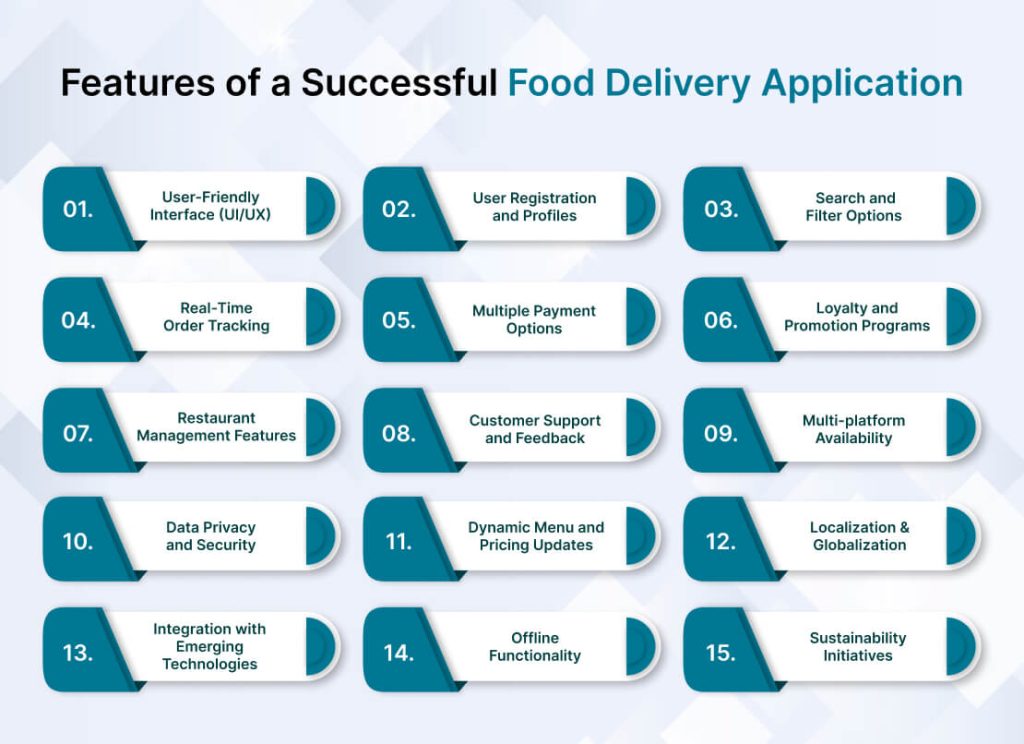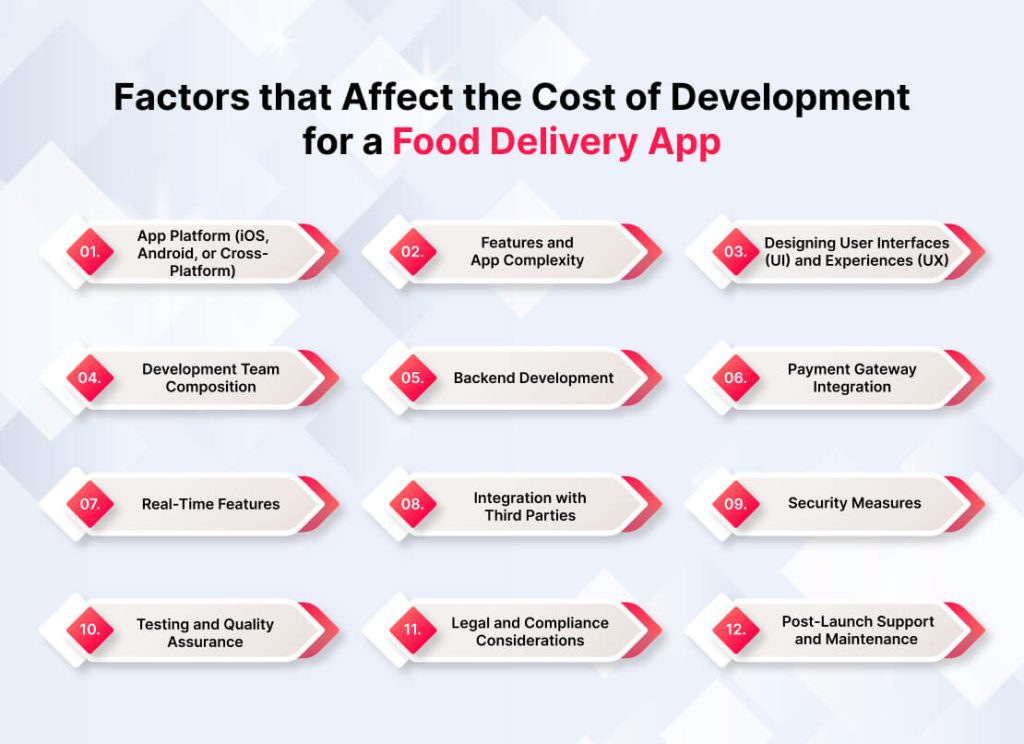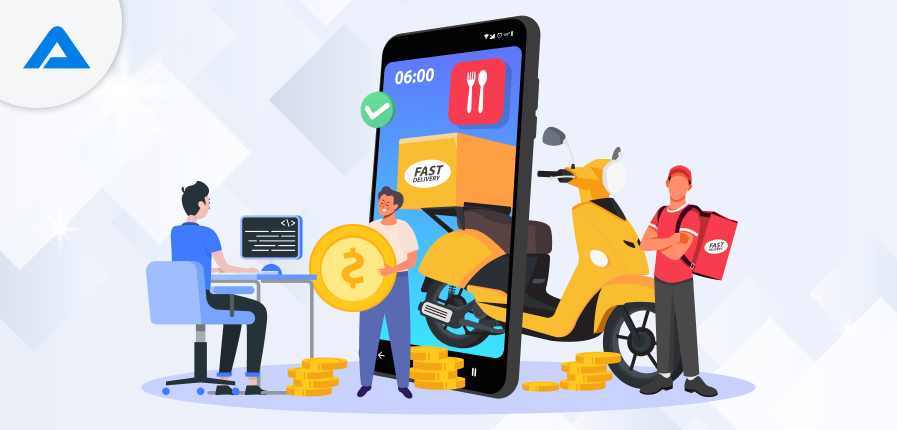Developing an application that delivers food is a technical endeavor and a strategy that requires meticulous planning. In an ever-competitive market, the intersection between user experience, technology innovation, and business strategy is crucial in determining whether such applications will be successful.
The blog explores two key aspects: the development process cost and its essential features. We dissect factors that affect the cost of food delivery application development, from the platform and features to the team’s experience.
We also explore the essential features of a successful food delivery app to ensure a smooth and satisfying experience for our users. This analysis is intended to help businesses, developers, and entrepreneurs navigate the complex landscape of developing food delivery apps. It will also foster an understanding of how cost and critical features are interconnected.
Features of a Successful Food Delivery Application

Here are some key features that make a successful food delivery app.
User-Friendly Interface (UI/UX)
A user-friendly application interface is essential for attracting users and keeping them. It should be easy to navigate, with a pleasing layout and an intuitive interface. An intuitive and easy-to-use user interface will ensure a smooth ordering process, increasing user satisfaction.
User Registration and Profiles
Successful food delivery applications should have a simple registration process. The users should be able to quickly create an account, whether through traditional means or using their social media credentials. The application must also allow users to customize their experience by creating profiles, saving favorite orders, and managing delivery addresses.
Search and Filter Options
Filtering and efficient search options enhance the user’s experience, allowing them to find restaurants of their choice or types of cuisine quickly. Users can narrow their options and improve satisfaction using filters based on cuisine, price range, and ratings.
Real-Time Order Tracking
Customer satisfaction is dependent on the transparency of delivery processes. Customers can monitor their orders from preparation through fulfillment in real time. Live updates about the driver’s location enhance trust and help reduce anxiety.
Multiple Payment Options
A successful food delivery app solution should accept various payment options, such as digital wallets, credit/debit cards, and cash-on-delivery. Diverse payment methods appeal to more users and facilitate a smooth checkout.
Loyalty and Promotion Programs
Promo offers, loyalty programs, and discounts can boost engagement with users. Customers tend to remain loyal to platforms that offer discounts, special offers, or freebies to their users.
Restaurant Management Features
A food delivery app should offer restaurant owners robust features to attract and keep them. This may include an intuitive dashboard, tools for managing orders, and analytics that track performance. Clear communication between the platform, restaurants, and their staff makes a smooth operation possible.
Customer Support and Feedback
It is essential to have a responsive system of customer service to address user concerns or questions promptly. A feedback system will allow users to communicate their experience and help the platform improve services by incorporating customer feedback.
Multi-platform Availability
Food delivery apps that are genuinely successful should support multiple platforms – iOS, Android, and web browsers are ideal. This ensures users have access to your app no matter their preferred device type, thus creating an even broader and deeper user base.
Data Privacy and Security
Any application’s security is essential, especially those that handle financial transactions. Data protection is ensured by implementing robust security measures such as encryption protocols or secure payment gateways. The application will gain credibility if it adheres strictly to privacy laws.
Dynamic Menu and Pricing Updates
The application must reflect any changes restaurants make to their menus and prices. The real-time sync of prices and menus ensures that users get accurate information. This reduces instances of confusion or dissatisfaction.
Localization & Globalization
The application’s appeal is increased in various regions by adapting it to the local language and preferences. Supporting global features, such as international cuisine and multi-currency options, cater to diverse users and increase the market reach of the application.
Integration with Emerging Technologies
A delivery app can differentiate itself from the competition by integrating new technologies such as artificial intelligence, machine learning, and augmented realities. They can create personalized recommendations, predict ordering, and provide immersive experiences.
Offline Functionality
Online connectivity is the standard, but offline functionality enables users to access the essential functions of an application, such as menus and placing orders, even if there are low or no connections.
Sustainability Initiatives
Sustainability features are appealing to users who care about the environment. Reducing packaging or promoting eco-friendly practices in partner restaurants may be possible.
Related Article:- Features and Tech Details for Food Delivery App Development – A Complete Guide
The Costs of Building a Food Delivery App
Costs associated with creating an app to deliver food may depend on several variables, including features, complexity, and location of your development team. An app with essential features like user registration, browsing menus, ordering, and payment integration may cost between $20,000 and $50,000.
The cost of a sophisticated food delivery app development, with features such as real-time tracking orders, complex backends, and loyalty programs, can be anywhere between $50,000 to $100,000. The cost of an app that uses cutting-edge technology and is highly customized or integrates with new trends, such as augmented reality and artificial intelligence, can exceed $100,000.
Consider ongoing costs such as server, maintenance, and updates. Prices can also vary significantly depending on developers’ hourly rates and location. Working with developers from regions with lower hourly rates could help you manage your costs while maintaining quality.
Factors that Affect the Cost of Development for a Food Delivery App

Several factors influence the cost of developing a food-delivery app. Developers and businesses need to understand these factors to make the best decisions.
Below, we will explore the factors significantly impacting the cost of developing a mobile food ordering app.
App Platform (iOS, Android, or Cross-Platform)
Platform selection has a significant impact on development costs. The cost of developing for iOS and Android is usually higher than if you choose a single platform. Cost savings can be achieved by using cross-platform frameworks like React Native and Flutter.
Features and App Complexity
Costs are primarily determined by the complexity of the app and its features. The essential elements are user registration, browsing menus, and placing orders. Advanced features add complexity and cost, such as real-time order tracking, push notifications, and AI-driven suggestions.
Designing User Interfaces (UI) and Experiences (UX)
The design of an app for food delivery must be visually appealing, user-friendly, and attractive. Costs are affected by the complexity and originality of UI/UX designs. Custom animations, intricate graphics, and detailed design elements can increase prices.
Development Team Composition
Costs are affected by the skill level and experience of a development team. Hiring a team of skilled developers with backend and mobile app design expertise is essential. Costs are also affected by the geographical location of a development team, as rates vary globally.
Backend Development
Costs are affected by the complexity of the backend infrastructure. A robust backend is required for real-time updating, order processing, and payment integration. Prices can be affected by using a third-party service or building your backend. Custom solutions require more resources and time.
Payment Gateway Integration
A food delivery application must integrate reliable and secure payment gateways. Payment gateway integration costs are determined by the complexity and number of supported payment methods, as well as any transaction fees.
Real-Time Features
Features such as live updates, order tracking, and chat support are all real-time functions that contribute to an enhanced user experience. Real-time features require additional costs and development effort. Real-time functionality can be complex, affecting a project’s budget.
Integration with Third Parties
Integration with third-party tools and services, like social media logins or analytics, mapping APIs to provide location services, etc., may impact the costs. Although leveraging existing services may save time in development, seamless integration can require extra effort. This is especially true if customizations are needed.
Security Measures
It is essential to ensure the safety of financial transactions and user data. Costs associated with development are increased by implementing robust security measures like data encryption, secure connections, and compliance with regulations. To build trust with users, it is essential to invest in security.
Testing and Quality Assurance
Apps that have bugs and issues must be thoroughly tested to find them. The development cost is influenced by quality assurance (QA), including functional, security, and performance testing. Testing entirely is vital to delivering a user-friendly and reliable application.
Legal and Compliance Considerations
Adhering to industry and legal standards is essential for a successful and credible food delivery application. Legal consultations, data protection laws, and licenses are all costs that can be added to the project budget.
Post-Launch Support and Maintenance
Support and maintenance are essential to ensure the app continues running smoothly. To address any unexpected challenges, the food delivery app development company should include the cost of maintenance and support after launch in the budget.
Conclusion
Cost and features are closely related and crucial to an app’s performance on the market and overall competitiveness. App development investment depends on several key variables, such as platform, complexity, level of backend development, and design considerations. Achieving an optimal balance between budget and essential features is necessary for creating user-friendly food delivery services with efficiency in mind.
Cost should never be the determining factor; features that improve user satisfaction and streamline operations are crucial to making an app successful and stand out in an increasingly crowded market. A user-friendly user interface, real-time order tracking capability, multiple payment methods, and robust security measures are critical to an app’s success with users.
Long-term sustainability depends on including the cost associated with ongoing post-launch support services like updates and compliance reviews. The dynamic nature of the industry is a constant need for adaptation. This includes adjusting to changes in user behavior and technology.
Businesses should ensure their operations can keep up with market demands while flourishing in an ever-evolving digital ecosystem. This will allow them to provide users with an enjoyable and seamless food delivery service.
